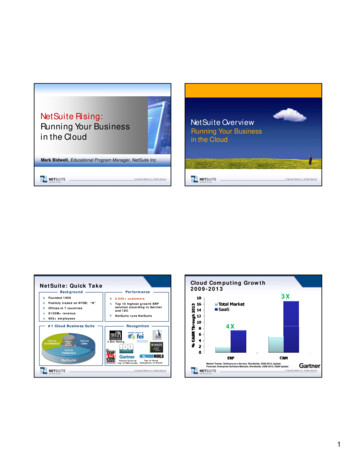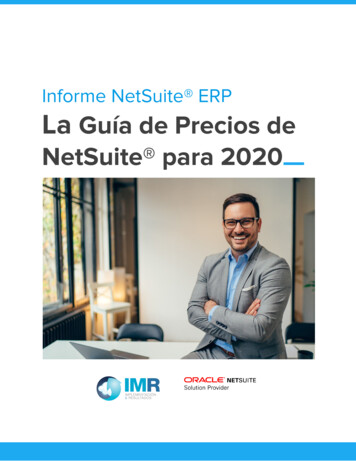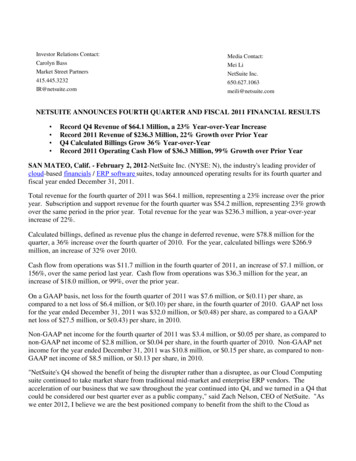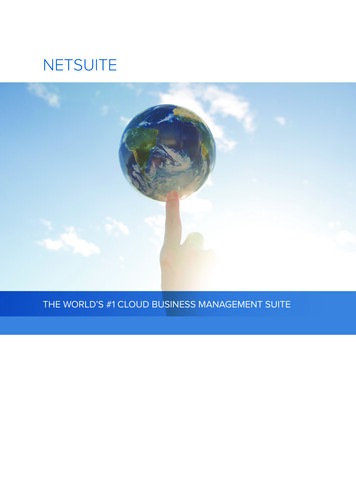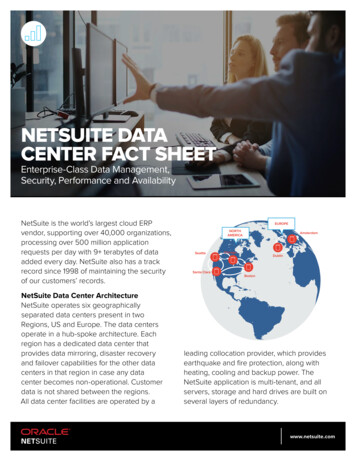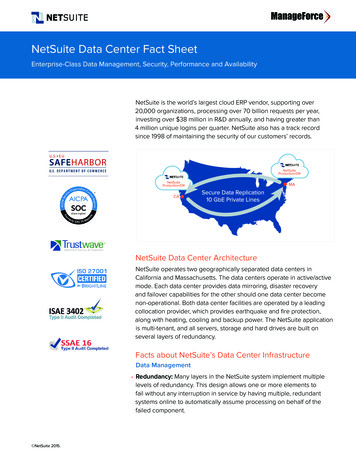
Transcription
PRODUCT GUIDEAMNION-CHORION ALLOGRAFTBARRIER MEMBRANE GROWTH FACTORIMMUNOPRIVILEGEDANTI-INFLAMMATORYACCELERATED HEALINGANTIBACTERIALLEAVE IT EXPOSED SAFE TO TOUCH TOOTH SURFACES REGENERATIVE
What is BioXclude BioXclude is the only minimally manipulated dehydrated humandeepithelialized amnion-chorion membrane available for use in avariety of dental, endodontic, oral maxillofacial, and periodontalregenerative procedures as a barrier, conduit, connector or cushion.Amnion-chorion tissue contains biological factors which aid in healing,promote angiogenesis, reduce inflammation and accelerate flapreattachment. It also possesses inherent anti-bacterial properties andthe tissue is non-immunogenic. (1-4, 7, 8, 16)The BioactiveAdvantageOver 280 preserved growth factors, cytokines and chemokines have beenidentified within BioXclude. BioXclude’s complex extracellular matrix compositioncombined with these retained biological factors offer critical advantages overother membrane materials, demonstrated in-vitro and in-vivo. (1-3, 5, 7, 8, 11-14, 16) Safely Exposed to theOral EnvironmentCell Occlusive BarrierGrowth FactorsAnti-inflammatory Decreased Post-Operative PainFacilitates Rapid Vascular GrowthRecruits Mesenchymal andHematopoietic Stem CellsHastened Epithelialization Hastened Flap ReattachmentMore Keratinized TissueStem Cell MagnetAntimicrobialAngiogenicCompositionA Paradigm Shift In Resorption KineticsBioXclude is composed of allograft amnionand chorion tissue. These layers represent theinner and outermost layers of the amnioticmembrane, the only barrier between themother and fetus, protecting both from eachanother’s immune system and infection. Italso serves as a shock absorber, preventsadhesion and regulates fetal temperature.Amnion tissue is rich in collagen types III, IV,and VI.9 Chorion tissue consists of a reticularlayer, a basement membrane containinga layer of dense connective tissue and atrophoblast layer. The reticular and basementmembrane layers contain collagen types I, III,IV, V, and VI.10BioXclude jump starts the natural wound healing process. It allows for rapid gingival epithelialcell migration and promotes neovascularization, enabling the rapid establishment of bloodsupply by activating the migration of human mesenchymal and hematopoietic stem cells.BioXclude stimulates the proliferation and migration of human microvascular endothelial cellsand causes these cells to produce and release angiogenic growth factors. The high concentration of Laminin-5 provides an ideal substrate for the attachment of gingival epithelial cells andDirectly Attached Tooth cells (DAT cells), which supports why BioXclude may be placed over exposed roots and is safe to leave exposed. BioXclude resorbs in 8-12 weeks, as demonstratedwith histology.17 BioXclude is truly a paradigm shift in resorption kinetics. It is a bioactive barrier,recruiting mesenchymal stem cells to the site, which differentiate between hard and soft tissuesbefore the matrix resorbs. Once this process begins, it’s faster resorption profile is ideal, allowingthe periosteum to take over. This process challenges the established theories regarding barrierProvenBactericidalmembrane characteristics which have been based solely on an inert scaffold model. (2, 5, 6, 10-12, 13-15)Placental tissues are inherently antibacterial, offering a safer, superior material to leaveexposed to the oral environment and placed in the maxillary sinus. In two separate studies,BioXclude was proven bactericidal, in contrast to porcine collagen, which promoted bacterialgrowth, and porcine pericardium demonstrating no antimicrobial activity. (7,8)Aggregatibacter actinomycetemcomitans *Note the zone of inhibition around the BioXclude disc4 /
SOCKET PRESERVATIONIMPLANTSOne Product.Simple.VERSATILE.PERI-IMPLANTITISGUIDED TISSUE REGENERATIONSINUS / FLAP PERFORATION REPAIRNEURAL PROTECTION / REGENERATIONADHESION BARRIERORAL WOUNDSNON-SURGICAL PERIODONTAL THERAPYKEEP ITMINIMALLY INVASIVE No flap elevation requiredSimply tuck BioXclude 1mmunder gingival marginEasily achieved with a reverse(inverted) suturing techniqueNO NEED TO TRIM NO NEED TO FIXATE No other product adheres tothe Schneiderian membranelike BioXcludeEasily applied dry, naturallyhydrates and seals the perforation like a patchNo need for further fixationThe physical properties of BioXclude allow clinicians to avoid many of the drawbacks associated with traditional collagen and synthetic membranes. This allowsfor a simplified, less invasive procedure resulting in less chair time.Witness the unique and beneficial handling characteristics that makeBioXclude more efficient and effective.Allow BioXclude to drape andadhereThis allows a larger piece tobunch up between the teethadjacent to the site, while alsoextending over the buccalportion of the graft, and ontonative boneUNMATCHEDADHESIONBioXclude Reinventsthe Membrane “Rules”BioXclude will stick to anyhydrated surfacePlace dry and allow it tohydrate to the site, or hydrateover the top with sterile salineBioXclude adheres like shrinkwrap NO NEED TO TRIM - LET BIOXCLUDE TOUCH ADJACENT TEETH NO ORIENTATION - PLACE UP OR DOWN, FOLD IT, ALLOW TO “BUNCH” UP SAFELY TOUCH ROOT SURFACES SAFELY TOUCH IMPLANT SURFACES PLACE OVER OR UNDER OTHER MEMBRANES, MESH OR PALATAL TISSUE LACKS RIGIDITY, EASILY ADAPTS AND ADHERES NO NEED TO TACK OR SUTURE THIN PROFILE - EASIER TO OBTAIN PRIMARY CLOSURE NO PRE-HYDRATION NECESSARY NO RETRIEVAL - FULLY RESORBS IN 8-12 WEEKS STORES AT AMBIENT CONDITIONS WITH A 5 YEAR SHELF LIFEPhotos courtesy of: 1)Jin Sub Oh, DMD, MS; (2,3)John Kim, DMD, MS, PA;4)Arthur Yagudayev, DDS, MS
Anterior Socket Preservation:Minimally-Invasive1.2.FDBA BioXclude4-day healing3.4.5-month re-entryImplant placement123456Photos courtesy of: Dan Cullum, DDS, Coeur D’Alene, ID211.2.3.3Photos courtesy of: Anthony Del Vecchio, DDS, Yorktown Heights, NYSocket Preservation:Significant Bony Defect1.2.3.24.5.6.10-day post-op6 month post-opImplant placementPosterior Socket Preservation:Minimally-Invasive41Pre-op PAFDBA BioXclude(2) Reverse figure-eightsuturesBuccal defectFDBA BioXcludeSite left exposed34.5.6.410-day healing3-month re-entryImplant placement56Photos courtesy of: Dan Holtzclaw, DDS, MS, Austin, TX123Immediate Implant4561.2.3.4.5.6.Failed implant removalImplant placementBone graft placementBioXclude placementPost-op viewRe-entryPhotos courtesy of: Robert Miller, DMD, Plantation, FLImmediate Implant:Moderate Facial Defect1.2.3.Buccal defectImplant placementBone graft placement4.5.6.BioXclude placementPost-op viewRe-entry123456Photos courtesy of: Robert Miller, DMD, Plantation, FL
Clinical CasesImplant Repair:Peri-implantitis11.2.3.2Pre-op implant #20Pre-op PADefect34.BioXclude in place5.(Grafted with Accell 6.Bone Putty)412-month post-op12-month PA56Photos courtesy of: Dan Holtzclaw, DDS, MS, Austin, TX123456Guided TissueRegeneration1.2.3.4.Pre-op #30DefectGrafted with FDBABioXclude placedinterproximally can flash hydrateBioXclude hydrated16-month post-op5.6.Probing DepthPre-Op 12 mm3 Months 3 mmPhotos courtesy of: Dan Holtzclaw, DDS, MS, Austin, TX1234561.2.Photos courtesy of: : Vinay Bhide, DDS, MSc, Ontario, CAN3.4.5.6.Guided Bone Regeneration:Double Membrane1.2.3.4.5.6.Extraction #23-26; tenting screws placedGrafted w/FDBACollagen membrane placedBioXclude placed OVER collagenNon-primary closure (vestibular dissectioninto chin performed to close the site).Pre-op/post-op PAGuided Bone Regeneration:BioXclude OnlyPre-op defectAutogenous scrapings / xenograft bone,BioXclude placedPrimary closure with PTFE8-month healing8-month re-entryImplants placed1234566Photos courtesy of: Dan Holtzclaw, DDS, MS, Austin, TX
Perforation Repair:Crestal Sinus Lift1.2.3.21Pre-op PASinus perforationBioXclude in place4.5.6.3FDBAVersah bur used. Implant placed.Immediate post-op PA456Photos courtesy of: Anthony Del Vecchio, DDS, Yorktown Heights, NY1.2.3.Sinus membrane perforationBioXclude placed dryBioXclude adheres to sinus and sealsperforation4.5.1Perforation Repair:Lateral Sinus LiftFDBA placedLateral sinus window covered withBioXclude2345Photos courtesy of: Dan Holtzclaw, DDS, MS, Austin, TXNon-Surgical PeriodontalTherapy AdjunctThese studies followed patients at 5-12 week re-evaluation of probingdepth following ScRP with BioXclude condensed into periodontalpockets of 5mm of greater. Note the consistent improvement achievedwith BioXclude regardless of the change in graft size.MEAN PROBING DEPTH IMPROVEMENTBioXclude Trial 110 x 13 mm189 Sites (5-6 mm)1.89 mm11 Sites ( 7mm)2.82 mmAll 20 Sites2.40BioXclude Trial 28 x 8 mm19ScRPOnly20ScRP withArestin 211.02 mm2.50mm1.98 mm 91%resolutionof BOP1.38 mmPeriodontal Laser Therapy BioXclude AdjunctInitialOne Week Post-OpDecreased post-op pain andinflammation accelerated healingSoft Tissue DonorSite ApplicationPhotos courtesy of: Nicholas Poulos, DDS, MS, Denver, COPre-OpPost-OpInitial PDAverage: 4.99 mmPost-Op PDAverage: 3.03mmPost-Op PD ImprovementAverage: 1.96mmPhotos courtesy of: Nicholas Poulos, DDS, MS, Denver, CO
Safety, Procurement and ProcessingOur placental tissue is sourced in the United States with informed consent from pre-screened mothers following elective cesarean sectiondeliveries only. The tissue is procured, processed, and distributed according to standards and regulations established by the AmericanAssociation of Tissue Banks and the United States Food & Drug Administration.Purion ProcessThis proprietary process safely and gently separates placental tissues, cleans and reassembles layers,and then dehydrates the tissue to preserve the key elements associated with healing. The Purion process removes blood components while protecting the delicate scaffold of the tissues, leaving an intactextracellular matrix. Following processing, the allografts are terminally sterilized (SAL 10-6)CHOOSING THERIGHT SIZE:No flap elevation:Tuck 1mm under gingivalmarginFlap Elevation:Cover all graft material;extend onto native bone3mmSinus Perforation:Extend 5 mm past edge ofperforationSize Choices8x8 mm12x12 mm*InnovationSupported By Research Ashraf H, Font K, Powell C, et al. “Antimicrobial Activity of anAmnion-Chorion Membrane to Oral Microbes”, InternationalJournal of Dentistry, vol. 2019, Article ID 1269534, 7 pages, 2019. De Angelis N, Kassim ZH, Frosecchi M, et al. “Expansion of thezone of keratinized tissue for healthy implant abutment interface using de-epithelialized amnion/chorion allograft.”Int J Periodontics Restorative Dent 2019; 39: e83-e88. Doi:10.11607/prd.3757. Cullum D, Lucas M. “Minimally invasive extraction site management with dehydrated amnion/chorion membrane (dHACM):Open-socket grafting.” Compendium 2019; 40(3):178-183. Temraz A, Ghallab H, Hamdy R, et al. “Clinical and radiographicevaluation of amnion-chorion membrane and demineralizedbone matrix putty allograft for management of periodontalintrabony defects: a randomized clinical trial.” Cell TissueBank 2019; Taalab M, Gamal R. “The effect of amniotic chorion membraneon tissue biotype, wound healing and periodontal regeneration.” IOSR J Dent Med Sciences 2018; 17(12):61-69. Solomon C, Kim M, Volk D, Kellert M. “The use of bioactivemembranes to enhance endodontic surgical and regenerative outcomes.” New York St Dent J 2018; 11:26-30. Maksoud M., Guze K., “Tissue expansion of dental extractionsockets using dehydrated human amnion/chorion membrane: Case series.” Clin Adv Periodontics 2018, 8:111-114. Holtzclaw D. “Repair of Dental Implant Induced Inferior Alveolar Nerve Injuries with Dehydrated Human Amnion-Chorion Membranes: A Case Series.” Imp Adv Clin Dent 2018;10(6):16-28. Hassan M, Prakasam S, et al. “A randomized split-mouth clinical trial on effectiveness of amnion-chorion membranes inalveolar ridge preservation: A clinical, radiologic, and morphometric study.” Int J Oral Maxillofac Implants 2017; 32:13891398. Prakasam S. “Dehydrated amnion-chorion membranes forperiodontal and alveolar regeneration.” Decis Dent 2017;3(8): 21-25.›10x20 mm15x20 mm*15x25 mm20x30 mm* most popular sizesPioneering Placental Tissue Science and Regenerative BiomaterialsSnoasis Medical has pioneered the development and use of placental tissue products fortissue repair and regeneration in dental-oral maxillofacial surgery for over 10 years. For moreinformation, review this sample of our scientific and clinical studies: Holtzclaw D, Tofe R. “An updated primer on the utilization ofamnion-chorion allografts in dental procedures.” J Imp AdvClin Dent 2017; 2(9):16-37. Nevins M, Aimetti M, Benfenati SP et al. “Treatment of moderate to severe buccal gingival recession defects with placental allografts.” Int J Periodontics Restorative Dent 2016;36:171-177 Holtzclaw D. “Dehydrated human amnion-chorion barrierused to assist mucogingival coverage of titanium mesh andrhBMP-2 augmentation of severe maxillary alveolar ridgedefect: A case report.” J Imp Adv Clin Dent 2016; 8(4): 6-16. Holtzclaw D. “Maxillary sinus membrane repair with amnion-chorion barriers: A retrospective case series.” J Perio2015; 86(8):936-940. Massee M, Chinn K, Lei J et al. “Dehydrated human amnion/chorion membrane regulates stem cell activity in vitro” JBiomed Mater Res Part B 2015:00B:000–00. Maan Z, Rennert R, Koob T et al. “Cell recruitment by amnionchorion grafts promotes neovascularization.” J Surgical Res2015; 193(2): 953-962. Chi S, Andrade D, Kim M, Solomon C. “Guided tissue regeneration in endodontic surgery by using a bioactive resorbablemembrane.” J Endod 2015; 41:559-562. April Rosen P, Froum S, Cohen W. “Consecutive case series using acomposite allograft containing mesenchymal cells with anamnion-chorion barrier to treat mandibular Class III/IV furcations.” Int J Perio Rest Dent 2015; 35:561-569 Holtzclaw D. “Open sinus healing comparison betweennon-perforated Schneiderian membrane and a perforatedSchneiderian membrane repaired with amnion-chorion allograft barrier: A controlled, split mouth case report.” J ImpAdv Clin Dent 2014; 6(8):11-21. Prakasam S. “Dehydrated amnion-chorion membranes forperiodontal and alveolar regeneration.” Decis Dent 2017;3(8): 21-25. Koob T, Lim J, Zabek N et al. “Cytokines in single layer amnion allografts compared to multi-layer amnion/chorion allografts for wound healing.”J Biomed Mater Res B 2014: DOI:10.1002/jbm.b.33265. Koob T, Lim J, Massee M et al. “Angiogenic properties of dehydrated human amnion/chorion allografts: Therapeutic potential for soft tissue repair and regeneration.” Vas Cell 2014;4(10): doi: 10.1186/2045-824X-6-10. Koob T, Lim J, Massee M et al. “Properties of dehydratedhuman amnion/chorion composite grafts: Implications forwound repair and soft tissue regeneration.” J BioMed MatRes Part B 2014:00B:000-000. Holtzclaw D, Cobb C. “Extraction site preservation using newgraft material that combines mineralized and demineralizedallograft bone: A case series report with histology.” Compendium 2014; 2 (35):107 - 112. Holtzclaw D, Toscano N. “Amnion–chorion allograft barrierused for guided tissue regeneration treatment of periodontal intrabony defects: A retrospective observational report.”Clin Adv Perio 2013; 3(3):131-137. Koob T, Rennert R, Zabek N et al. “Biological properties ofdehydrated human amnion/chorion composite graft: implications for chronic wound healing.” Int Wound J 2013;10(5):493-500. Rosen P. “A case report on combination therapy using a composite allograft containing mesenchymal cells with an amnion–chorion barrier to treat a mandibular Class III furcation.”Clin Adv Perio 2013; 3(2):64-69. Holtzclaw D, Hinze F, Toscano N. “Gingival flap attachmenthealing with amnion-chorion allograft membrane: A controlled, split mouth case report replication of the classic1968 Hiatt study.” J Imp Adv Clin Dent 2012; 4(5):19-25. Rosen P. “Comprehensive periodontal regenerative care:Combination therapy involving bone allograft, a biologic,a barrier, and a subepithelial connective tissue graft to correct hard- and soft-tissue deformities.” Clin Adv Perio 2011;1(2):154-159. Holtzclaw D, Toscano N. “BioXclude placental allograft tissuemembrane in combination with bone allograft for site preservation: A Case Series.” J Imp Adv Clin Dent 2011; 3(3):35-50.REFERENCES: [1] Koob T, Rennert R, Zabek N, et al. Biological properties of dehydrated human amnion/chorion composite graft: implications for chronic wound healing. Int Wound J 2013: doi: 10.1111/iwj.12140. [2] Koob T, Li W, Gurtner G et al. Angiogenicproperties of dehydrated human amnion/chorion allografts: therapeutic potential for soft tissue repair and regeneration. Vas Cell 2014; 4(10): doi:10.1186/2045-824X-6-10. [3] Koob T, Zabek N, Massee N, et al. Properties of dehydrated human amnion/chorion composite grafts: implications for wound repair and soft tissue regeneration. J BioMed Mat Res Part B 2014:00B:000-000. [4] Xenoudi P, Lucas M, Chlipala E, et al. Comparison of porcine and amniotic resorbable collagen membranes using H&Estaining and immunohistochemistry. Manuscript in Preparation. Data on file at Snoasis Medical. [5] Holtzclaw D, Toscano N. Amnion chorion allograft barrier: indications and techniques update. J Imp Adv Clin Dent 2012; 4(2):25-38. [6] Holtzclaw D,Cobb C. Extraction site preservation using new graft material that combines mineralized and demineralized allograft bone: a case series report with histology. Compendium. Feb 2014; 107-112. [7] Ashraf H, Font K, Powell C, et al. Antimicrobial Activityof an Amnion-Chorion Membrane to Oral Microbes, International Journal of Dentistry, vol. 2019, Article ID 1269534, 7 pages, 2019 [8] Palanker N, Lee C, Tribble G, et al. Antimicrobial efficacy assessment of human derived amnion-chorion. University ofTexas at Houston Health Sciences Center Graduate Periodontics (Houston, TX). Poster presentation #27 at American Academy of Periodontology Meeting 2018, Vancouver, BC. Manuscript in preparation. [9] Hodde J. Naturally occurring scaffolds for softtissue repair and regeneration. Tiss Eng 2002; 8(2): 295-308. [10] Niknejad H, Peirovi H, Jorjani M, et al. Properties of the amniotic membrane for potential use in tissue engineering. Euro Cells Mat 2008; 15: 88-89. [11] Holtzclaw D, Toscano N. BioXclude placental allograft tissue membrane in combination with bone allograft for site preservation: A Case Series. J Imp Adv Clin Dent 2011; 3(3):35-50. [12] Wallace W, Cobb C. histological and computed tomography analysis of amnion chorion membrane inguided bone regeneration in socket augmentation. J Imp Adv Clin Dent 2011; 3(6): 61-72. [13] Holtzclaw D, Hinze F, Toscano N. Gingival flap attachment healing with amnion-chorion allograft membrane: A controlled, split mouth case report replicationof the classic 1968 Hiatt study. J Imp Adv Clin Dent 2012; 4(5):19-25. [14] Holtzclaw D, Toscano N. Amnion–chorion allograft barrier used for guided tissue regeneration treatment of periodontal intrabony defects: A retrospective observational reportof 64 patients. Clin Adv Perio 2013; 3(3):131- 137. [15] Chen A, Tofe A. A literature review of the safety and biocompatibility of amnion tissue. J Imp Adv Clin Dent 2010; 2(3):67-75. [16] MiMedx Research Report. MM-RD-00022: EpiFix and AmnioFix TotalGrowth Factor Content. [17] Wallace W, Cobb C. Histological and computed tomography analysis of amnion chorion membrane in guided bone regeneration in socket augmentation. J Imp Adv Clin Dent 2011; 3(6):61-72. [18] Schwab M. Innovativeaddition of dehydrated human amnion-chorion membrane during scaling & root planing. Private Practice Clinic (Denver, CO). Snoasis Medical Report Data on File 2016. [19] Dodge J, Rademacher A. Dehydrated human amnion-chorion product as anadjunct to scaling & root planning in maintenance patients: A pilot study. Private Practice Clinic (Boulder, CO). Submitted for Publication. [20] Hung H, Douglas C. Meta-analysis of the effort of scaling and root planning, surgical treatment and antibiotictherapies on periodontal probing depth and attachment loss. J Clin Perio 2002; 29: 975-986 [21] G. Minocycline HCI microspheres reduce red-complex bacteria in periodontal disease therapy. Goodson J, Gunsolley J, et al. J Perio 2007; 78 (8): 1568-1579./ 7PR101901v02
TheAdvantageBIOLOGICALCLINICIANPATIENTGrowth factors 'Barrier MembraneImmunoprivileged, likeLower cost and lessSafe ' AffordableNo need forautologous graftscan touch tooth surfacesAccelerated early leave exposedhealing/attachmentAnti-inflammatoryMore: Bone, KeratinizedtissueAntibacterialchair timeNo rules: No trimming,Less rejections, reactions,venipunctureLess concernLess post-operativepain and inflammationpost-operative pain andLess unnecessarycontraindicationspost-operative visitsConsistent, shelf stableBetter clinical results HAPPIER PATIENTSproductTHE ONLY AMNION-CHORIONBIOACTIVE BARRIER MEMBRANEAVAILABLE FOR USE IN THE DENTAL FIELD TODAYFOR MORE INFORMATION,CONTACT US:Phone: 866-521-8247Email: sales@snoasismedical.comFax: 720-259-1405Follow us onInstagram for more cases@SNOASISMEDICAL#BIOXCLUDE8 /W W W. S N O A S I S M E D I C A L . C O M
8x8 mm 12x12 mm* 10 x20 mm 15 20 mm* 15 25 mm 20x30 mm Ashraf H, Font K, Powell C, et al. "Antimicrobial Activity of an Amnion-Chorion Membrane to Oral Microbes"International , Journal of Dentistry , vol. 2019, Article ID 1269534, 7 pages, 2019. De Angelis N, Kassim ZH, Frosecchi M, et al. "Expansion of the

